I was at a local shop last month wanting to buy an X-Men #120. The book was certified by CGC as a 9.0 but the slab was cracked and scuffed so I thought maybe I could negotiate a deep discount. But instead, the store owner (let’s call him John) was asking double the market value. John explained that he had just gotten the book and didn’t have the chance to break it out of the case yet so that he could price it as a 9.4.
“What…? But it’s a 9.0,” I replied, “in a cracked case…!”
“Not to me,” he stated, “I’m going to remove it and sell it as a 9.4”.
“But CGC is the standard…” I reminded John.
“I’ve been in the comic business a long time. I’ve got more experience than those guys at CGC… It’s a 9.4 because I say it’s 9.4!” John exclaimed.
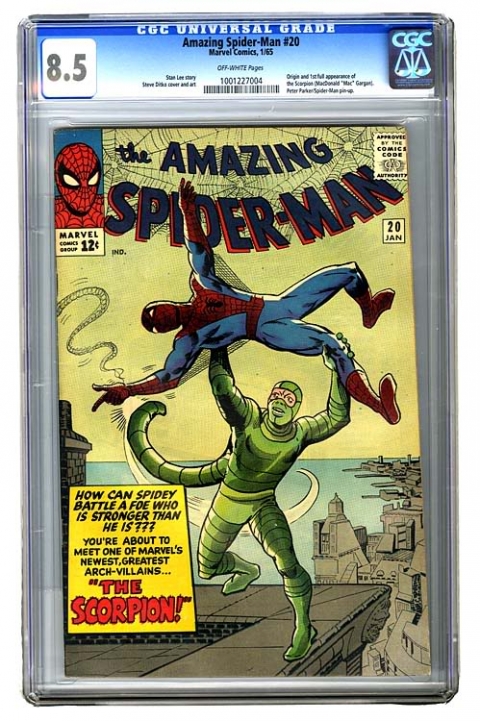
Needless to say, the deal never happened and I had to laugh. It’s easy to shake our heads and label John as a scum bag… but this is very common practice. Not just among dealers but collectors as well. Buyers with a keen eye know how to spot a sharp certified book, break it out of its case and pass it off as a higher grade book. In my previous write up, I considered doing the same to a couple of books I received from CGC recently. Both my Adventure into Fear #19 and Hulk #141 presented very well for their assigned grade, but got hit due to a light water stain on the back cover, awarding both books a measly 4.5. I felt that these books were comparable to a 6.0 or even higher but evidently not by CGC or Overstreet standards.
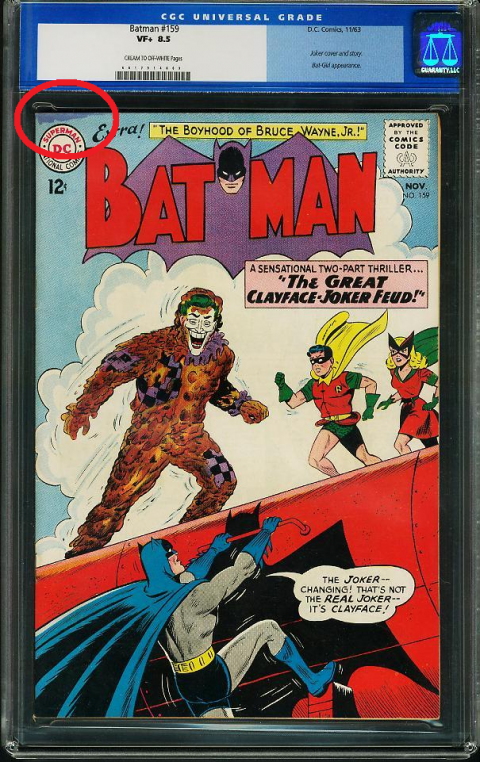
Apparently, distribution ink that spills over can still achieve a 9.8.
It was difficult to be upset at John. After all, he is a business man, he has been dealing in comics a very long time and he is free to grade the books as he feels fit. Overstreet and CGC may have their guidelines but it’s not a perfect scale and no one says we have to follow their standards. As well, the results from Overstreet and CGC are often inconsistent, but how could it be otherwise? No one person can grade all the books in the world, and even if they could, mood and frame of mind affect us all. The counter argument, of course, is that John stands to benefit from grading his own book higher, so his judgement lacks objectivity and is extremely bias in favour of his book. And whether you agree with Overstreet or not, it is a bench mark that helps collectors to communicate, unifying the community, much like having rules in sports, so that we can all play the same game. Also, if and when the time comes to sell the book, it would be difficult for me to pass off the book as a 9.4 with the qualifier that “John” says it’s a 9.4. I mean… who the heck is John? Whether he is right or wrong about the grade, what weight does his opinion carry? Still, there is a large group of dealers who refuse to deal in CGC books because they simply don’t believe in it. Perhaps these dealers are stuck in the past but if you’ve been in the hobby long enough, I’m sure you can also understand their frustration with certification.
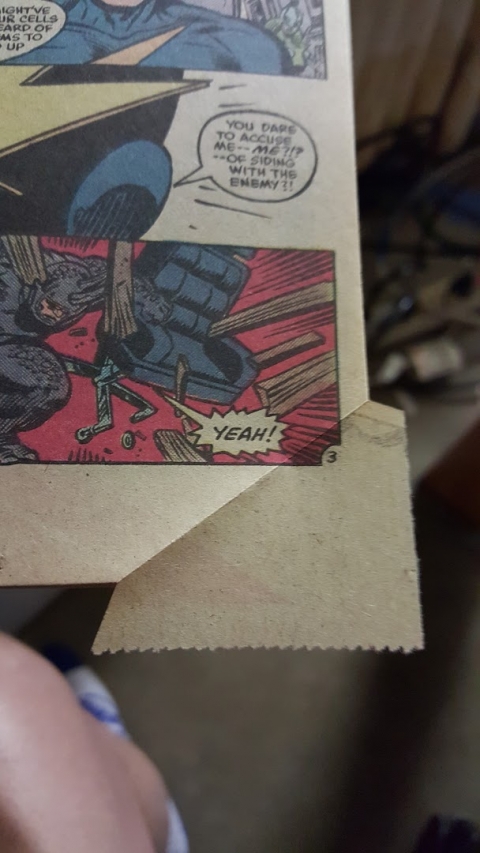
The reverse can also be ethically confusing…
The other book that I discussed in my last post was Luke Cage, Hero for Hire #1. In my write up, I state that my strategy in selling this book is to keep it slabbed as a CGC 7.5 so that a potential buyer could not look inside. The book itself is in fairly nice shape but suffers from an overspray of distribution ink. The covers don’t look too bad and but the inside is definitely a turn off. The quirk here is that for some reason, Overstreet and CGC tend to hammer books for having a water stain and yet are forgiving when it comes to distribution ink. I’m not clear why they do this, but I’d much rather have a light stain instead of dark ink. I suspect it may be a case of manufacturing versus handling. If a book is manufactured with flaws, then it is what it is. For example, many Silver Age books have off-set staples but that is simply the result of the technology at the time. However, if book has acquired flaws after having left the printer, then it’s been “damaged”. A condition that is not of the original state and something that could have been avoided. While there is a logic to this rationale I don’t agree with this line of thinking (if indeed this is the case). We all know what a perfect “10” should look like and so I personally think that the grade should be determine by how far removed a book is from that perfect “10”, regardless of how, why and where the book became flawed. In other words, it should be determined by the net result and not the process, even if the process is unavoidable. Other examples of this are miscut books, bad cover wraps and dog eared pages. In all these cases, the certification tends to work in your favour. If anyone disagrees with the grade, you can simply point out that the pros at CGC have certified it as such and no matter how severe the flaw, you can basically leverage CGC’s opinion to help sell the book.
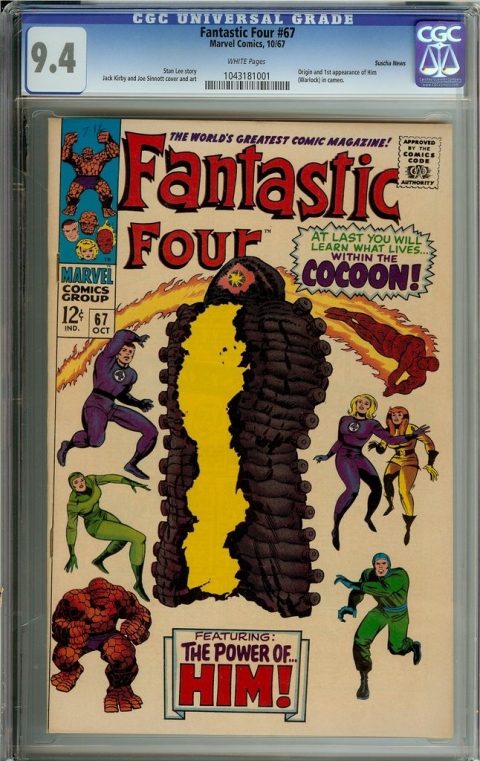
So what are we to make of all this? Well, philosophically speaking I would say that both actions or scenarios are wrong or dishonest since it misrepresents or conceals the truth… but who’s truth are we talking about? We can certainly delve deeper into a discussion of morals and ethics but this is a comic book forum so practically speaking, we all want an advantage. The practice is wide-spread and we also know that CGC often get things wrong themselves. So is it unethical to disagree or agree with them? I don’t think it is, but when we stand to gain from our own assessment it puts the authenticity of our belief into question. That is, are we being honest about what we think… or have we “convinced” ourselves to think a certain way due to a personal bias, or worse, are knowingly lying to ourselves for the sake of a pay day?
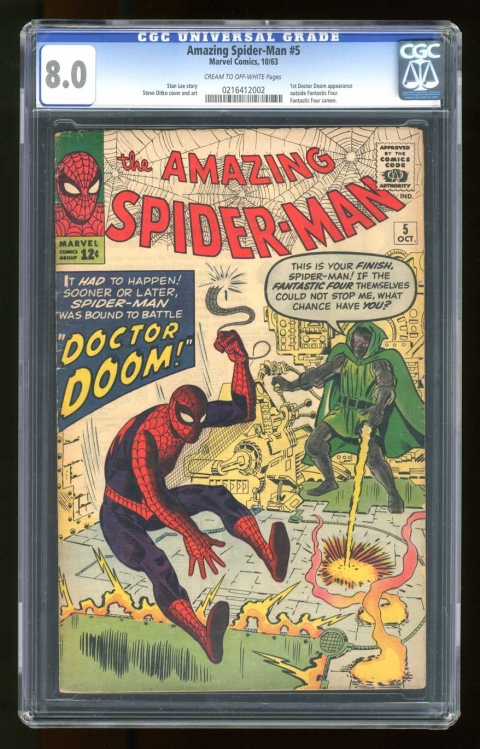

People are emotional creatures and science has determined that people will believe what they want to believe. In other words, we are deluded and flawed by nature. So, despite my failed attempt to pick up a cheap X-Men #120 from John, I don’t hold any ill feelings toward him. Yes, his judgement is questionable but I think we can simply chalk it up to salesmanship.
No book is 100% free from flaws so I think the solution is to become familiar with the various defects. Eventually, a personal preference will develop but at the same time, it’s important to keep in mind how Overstreet and CGC may assess the imperfections, especially if resale is on your mind. In the mean time… does anyone need a sharp looking Fear #19 or Hulk #141 that looks like a 6.0… or maybe even a 7.0?

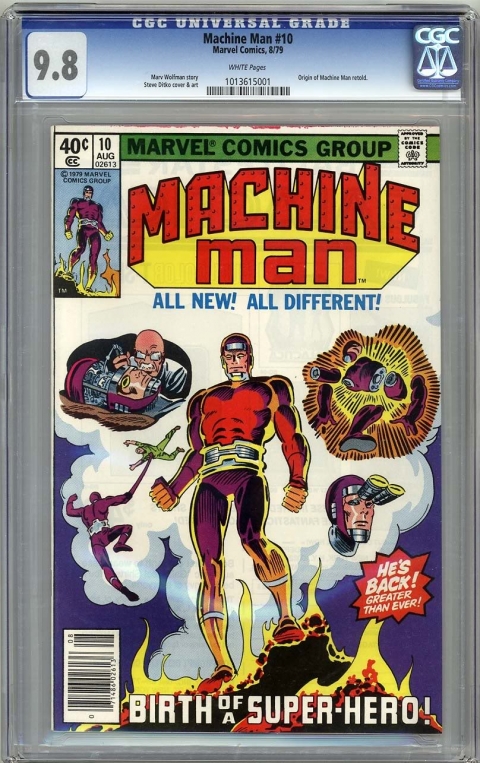



Thank you Charlie for another great article that brings about a great dialogue when it comes to investing in Comics.
Curious about a book that’s on Ebay at the moment that has 2 defects on the front cover (Showcase #37 CGC 8.0 white pages). I contacted the seller of the book, who in my opinion, happens to be awesome and a great communicator. I asked for the CGC notes and he replied that CGC did not have any notes that could justify the grade given. The reason I asked for the CGC notes was because on the front cover there’s a very visible scuff (as if tape touched the book) and a small tear atop of the cover title that really affects the overall eye-appeal. After discussing this with a friend of mine who was once a grader and discussing it a comic book store owner in my area we strongly believe that it should be graded between a 5.0-6.0. I really love the Metal Men and was offering to trade in a rare top graded Canadian dollar bill from 1935 that far exceeds the value of the book for that book and possibly others. Let me know what you think. I provided the link to the book below:
http://www.ebay.com/itm/Showcase-37-KEY-CGC-8-0-WHITE-Pages-1st-Metal-Men-Mar-1962-DC-Comics-/391399541279?hash=item5b213b0a1f:g:A6kAAOSwa-dWns0J
Charlie,
Nice work and a well-rounded. look. Though I would still call your dealer “greedy” rather than a good businessman, at least at first blush. Also think that there is supposed to be an innate trust between the buyer and the dealer, if the dealer is offering his expertise. So you are correct, it is conflict of interest for him to break the book open and upgrade it. The most fair way to deal with that is for him to disclose the CGC grade and explain his own grading, Or send it back to CGC for another go-around. The buyer should have full knowledge and make his decision based on who he trusts more, dealer or CGC. When grading gets into the tenths of a point in the 9.0 level, I think there are very few people who can really be counted on for an accurate grade. I don’t consider myself one, by any means.
In fact, I don’t play the CGC game but I do have respect–up to a point–for dealers who do. I buy Golden Age mid-grade books for my own collection and if they happened to be slabbed, I break them open to read them and just keep the label.
I generally find CGC to be reasonable in their grading. I trust them more than I do Heritage, who I buy regularly from on the Sunday nite auctions. But I’m only buying books up to around 8.0, since we’re talking Golden Age. Much of my stuff is 4.0 to 6.0, and sometimes purple label. since I’m more than willing to buy restored books at the right price.
But I most appreciate your pointing out CGC’s myopic view of printing and distribution defects, such the miscut book and distribution inks. In fact, I got a CGC JLA #12 graded 8.0 that had what they must have considered to be an arrival date, but it wasn’t, it was some kid with a grease pencil putting a number in the middle of the cover. I was VERY disappointed (I didn’t look close enough at the scan online, obviously). I left the container intact, and sold the book at a big discount off guide to a CGC fan who was enamored with their grading more than with my complaint.
CGC SHOULD qualify ALL defects, as you say, because a book with such a defect cannot grade at the same level as a book without that issue. That’s bogus. I’d go so far as to at least mention arrival dates–and if they are significant, such as large pencilled dates, or huge “file copy” stamps, they should be qualified.
I think CGC has listened to too many dealers and is serving the dealer community more than the purchaser, in cases like this.
Thanks for your comment Angelo. Personally, I don’t find grader notes very helpful in understanding how CGC grades. There seems to be just as many remarks for a high grade books as there are for low grade books. I suspect it has more to do with the specific flaws themselves and how they affect the overall presentation. I do believe that CGC is more lenient with older books and this may be the case with your Showcase #37. However, if you’re asking my opinion about the grade, based on the picture, its seems about right to me… or maybe a 7.0? The cover is very square and nicely wrapped, no detracting creases or obvious flaws other than what you’ve mentioned. Even with the very small tape pull and a little tear, I think it presents much nicer than a 5.0. But I’m not a pro and at that price, I’m sure you’d want to eliminate any doubt. A very nice looking book otherwise… Good luck with the hunt ^_^
Long time reader, first time posting. I used to collect CGC, but stopped and sold all of my CGC books, with a couple of exceptions. Firstly, I sold the CGC copies because I wanted books that I could read should I want to. Not everything is available in trade, and I like actually reading my collection and take the proper precautions to do so without impacting condition. I think the people who made the books would be glad that they are still being read and enjoyed. Secondly, I started to feel the same way about CGC inconsistencies as a lot of people clearly have. My biggest issue being that CGC doesn’t seem to have nearly as much competition in the comic book grading business. Yes, I know that PGX and CBCS exist but there are just so many more CGC graded books out there that I rarely see books graded by other companies, and when I do they take a price hit for simply not being CGC. Lastly, I have never liked CGC’s pricing model. I’m not going to get into specifics but I think they massively over charge (they charge based on a percentage of fair market value but nobody there has ever been able to tell me how they arrive at the number they think the book is worth. Sketchy.) My only caveat is that I have several signature series slabbed books. I see no way to get around that. If a book is signed then a grading company needs to be involved to verify the signature. For that situation I think comic book grading is enormously valuable. For simply buying and selling books I prefer to hold it in my hand, actually be able to look inside and make my own call. I find CGC inconsistent at best, and at worst… well, the examples in this article speak for themselves (particularly that Amazing Spider-man #5.) This was a great article and thanks for writing it.
Hi Bud…
• I often equate buying and selling vintage books to that of dealing in used cars. The problem with CGC is that you can’t look under the hood. I think in most cases, CGC does a good job. But I do disagree with some aspects of their business and I think there is a lot of room for them to improve.
• Regarding date stamps… As long as they are discreet, Overstreet does not see it as a detractor. In fact, much like antiques, they state that it adds character and is a reflection of the times. However, without any formal guideline, it becomes one of those highly subjective matters since date stamps vary in size, colour, placement and are often hand written with pencil, pen, marker or… a grease pencil. One good thing about grease pencil markings is that they can usually be removed.
• I’ve met some good dealers and bad dealers but if I had to generalize, I would say that the biggest culprits of bad behaviour are collectors turned dealers. Quick story: I usually set up at the local one day show. Often, guys would come by wanting to sell their books. I made one such guy an offer and he accepted. It’s a busy show so I don’t have time to open each bag and scrutinize each book. However, when I took the books home and had a closer look, many of the books were grossly restored. I confronted him about it at the next show and he just laughed in my face and blew me off. In other words, he knowing sold me junk books and had no remorse about it. To him it was a game of buyer beware. I could have escalated the situation but it wasn’t worth the trouble for a couple hundred bucks. Here’s the scary thought… he now sets up at the show. Needless to say that I won’t deal with him anymore but you have to wonder how many other unsuspecting buyers he’s sold to. From my personal experience, most full timers tend to be honest people. I think they have to be because their livelihood depends on it. It’s the part timers who care little about their reputation that can be trouble some. As a part timer myself I want to make money from my books as well but nothing good comes from hurting people. If your buyers are not happy, I think it reflects poorly on the seller. I could tell you more stories but then I’d be ranting… ^_^
Great comments Bud. As I always preach, I think the key is awareness…
Hi Robert, I agree with you 100% because what you’ve expressed is basically how many of us feel. However, let us not forget how CGC came to be… CGC is an extension of the world wide web, i.e. Ebay. Before CGC, buying books online was like the wild wild west. It was a risky endeavour with many sellers cleverly masking their inferior book with a blurry image and a description that states… “In my opinion, this book is in VF condition”… only to receive a VG copy instead. Perhaps it will always be a love/hate relationship with CGC but when buying books online, I do feel it is the less of two evils.
Thanks commenting. Hope to hear more of your thoughts.
Just to give an update…
In order to get ahead of the schedule, I wrote this article about one or two months ago. Since then, I sold my Luke Cage #1 for $360 USD. I originally purchased the book for $300 CAD and paid a few $$ to have it graded. So basically my profit is what ever I can get from the exchange rate. With the Netflix TV show on the horizon, I would have liked to hold out for more, especially since the book is heating up, but it was part of larger package so I was happy to part with it. The funny thing is, the person who bought the book was the person who sold me the book in the first place. Ha.
I still have the Hulk #141 and Fear #19. I’ve decided to hang on to these for now since I wont be able recoup my cost. Perhaps I’ll bundle these up again if there is another opportunity.
Also of interest, there was a guy on the CGC boards who recently sold his X#94… again graded 4.5 due to a water stain. He sold it on eBay at market value and the buyer cracked it open and relisted the book as a raw VF/NM or 9.0. The CGC board members responded in kind with anger. The seller claimed that he received threats and ended his auction. You can read through the comments here:
http://boards.collectors-society.com/ubbthreads.php?ubb=showflat&Number=9176157&fpart=1
Hi Charlie,
I agree that for buying online it can be just as reassuring as it is for verifying signatures. It is a premium for peace of mind, to a degree. Do you only buy CGC online or are you okay with trusting a different grading companies when purchasing on ebay? I used to think ‘The devil I know’ but lately I’ve seen a couple of CBCS books that look fairly graded. What is your experience with other grading companies been like? I’ve been eyeing this DC Comics Presents #26 on FeeBay and it is a signature series 9.0 but by CBCS.
Hi Robert.
For the bigger books, $500 – $5000 I primarily buy and sell online. I don’t mind buying PGX or CBCS but as you’ve noted, they do take a hit during resale so I have to factor this in. Personally, I think they’re all the same, although many consider PGX grades to be 1 notch lower than that of CGC but it could be that their scale is different, which if fine as long as they are consistent. CGC has the advantage because they’ve got the lead and have the infrastructure. They’ve got their online forums, memberships, census and back end deals with Overstreet and the various auction houses. CBCS commands a lot of respect and has gained some traction. They are more economical and is currently the lead competitor but they’ve still got a long ways to go.
One of the problem is the mind set of the collector. Collectors want all their books to be from the same grading company so that it all looks nice and orderly in a box. I actually believe that CBCS would benefit from using the exact same plastic cases as CGC so that their graded books will stack perfectly with CGC books. If you’re simply flipping books, it’s not a big deal but collectors tend to be very anal.
I don’t submit a lot of books to any of the grading companies. I find the process really slow and the cost of slabbing a book can really dig into your margins… and it’s too much of a gamble. One badly restored book and it could really mess up your finances. I prefer to pick off low hanging fruit and work the spread instead.
It all comes down to what your objectives are. Collector? Reader? Dealer? Flipper? I’m currently trying to sell my books so I’m primarily focused on how to achieve top dollar. As such, I care less about the actual book, the grade or the grading company and I’m more concerned about what buyers want and how they think. Still, it’s hard to completely eliminate the collecting mindset. Lifelong habits are hard to break so I’m making a conscious effort to buy less these days unless it’s an investment opportunity.
Great post and very good comments all around.
You will search long and hard for a dealer or long time collector who doesn’t think they know as much or more than CGC and their grading. My own experience with CGC has been mixed. I figure if they land within .5 +- of the grade I expect, they have it right. In all of the CGC books I have purchased and cracked open and the few I have had personally sent in they have achieved about 70-75%. the balance have been over or under my expectations. I only seem to remember the one’s that were under!
Still laughing at that FF#67 you posted.
I might have a deal for you on the Hulk #141, e-mail me when you get a chance.